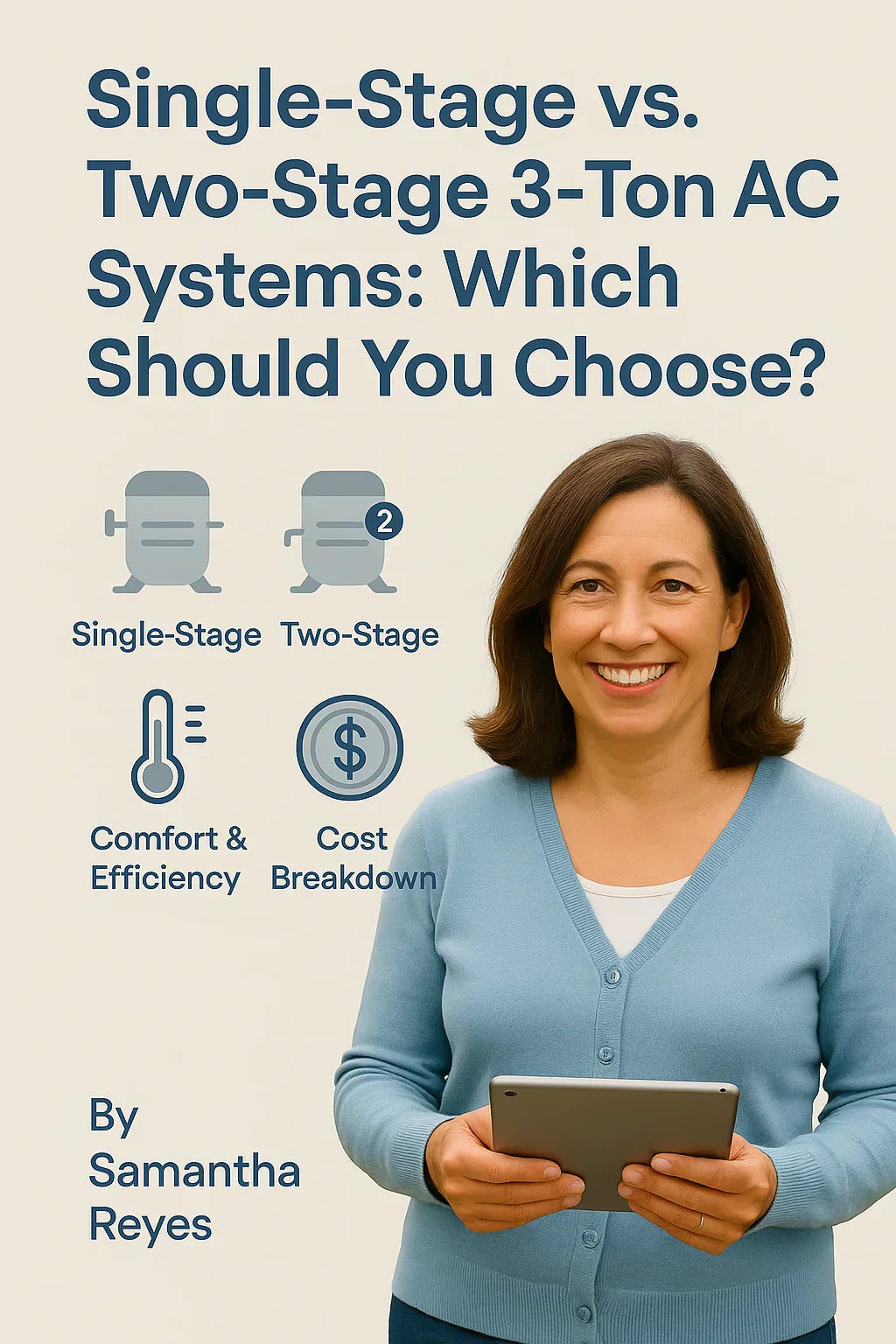🏡 Why Staging Matters More Than You Think
Hi friends, Samantha here.
When I first started shopping for my 3-ton AC upgrade, I thought I’d just be choosing between brands and SEER2 ratings. But my HVAC contractor threw me a curveball:
“Do you want single-stage or two-stage?”
At first, I thought it was just a fancy upsell. But after a lot of research (and living with both types), I realized that the compressor stage you choose affects comfort, energy efficiency, noise, and even how long your AC lasts.
This guide is my way of helping you navigate that decision — with real homeowner perspective, technical insights, and practical budget tips.
⚙ What Does “Stage” Mean in AC Systems?
The “stage” refers to how many cooling output levels your AC’s compressor can operate at:
-
Single-stage: On at 100% capacity or off — no in-between.
-
Two-stage: Can run at ~70–80% capacity for lighter loads or 100% for peak demand.
Think of it like a car:
-
Single-stage = pedal to the floor or no gas at all.
-
Two-stage = cruise control when you don’t need full power.
📊 Basic Technical Differences
| Feature | Single-Stage | Two-Stage |
|---|---|---|
| Compressor Speeds | 1 | 2 |
| Energy Efficiency | Baseline | Higher |
| Indoor Humidity Control | Fair | Better |
| Temperature Stability | Fluctuates more | Steadier |
| Noise Level | Louder during run cycles | Quieter on low stage |
| Upfront Cost | Lower | Higher |
| Maintenance Complexity | Lower | Slightly higher |
🌡 Comfort Differences: Where Two-Stage Shines
Temperature Consistency
-
Single-stage units cool quickly, then shut off. That’s fine… until the temperature drifts up, and it blasts on again.
-
Two-stage units run longer at low speed, avoiding hot/cold swings.
Humidity Control
In humid climates (I live in one), moisture removal is key.
-
Single-stage: Short cycles mean less time to dehumidify.
-
Two-stage: Longer low-stage operation wrings out more moisture, keeping humidity ~45–50% indoors.
💡 According to Energy.gov’s humidity guidelines, every degree drop in indoor humidity can make the air feel 1–2°F cooler without lowering the thermostat.
🔇 Noise Considerations
When my old single-stage Goodman ran, you could hear the compressor kick in from the driveway. My new two-stage model’s low-speed mode? Barely noticeable — inside or out.
If outdoor noise is a concern (especially with a unit near a bedroom), staging makes a noticeable difference.
⚡ Energy Efficiency & SEER2 Ratings
Single-Stage
-
Typically found in 14.3–16 SEER2 models.
-
Short cycles = higher peak energy draw.
Two-Stage
-
Often 16–20 SEER2.
-
Low stage uses less electricity and reduces compressor strain.
💵 Upfront Cost vs. Long-Term Savings
Here’s what I found comparing quotes for a 3-ton Goodman and Lennox install in 2025:
| Type | Equipment Cost | Installed Cost | Est. Annual Energy Use | 10-Year Energy Cost @ $0.14/kWh |
|---|---|---|---|---|
| Single-Stage (15.2 SEER2) | $3,200 | $6,100 | 3,500 kWh | $4,900 |
| Two-Stage (17 SEER2) | $4,000 | $7,200 | 3,150 kWh | $4,410 |
Difference:
-
+$1,100 upfront for two-stage
-
~$490 saved in 10 years on energy (more if rates rise)
-
Comfort & humidity gains are the real bonus.
🔧 Maintenance & Reliability
Single-stage:
-
Fewer parts, simpler design.
-
Lower repair costs, but more frequent on/off cycling can wear components faster.
Two-stage:
-
Slightly more complex electronics and compressor design.
-
Running on low stage reduces start/stop stress, potentially extending life.
My HVAC tech told me:
“Most failures happen at startup. Two-stage systems just have fewer of those in a year.”
🗺 Best Fit Scenarios
Choose Single-Stage If…
-
You’re on a tight upfront budget.
-
You live in a dry climate with low humidity.
-
You’re replacing a rental property AC (lower install cost, basic comfort).
Choose Two-Stage If…
-
You live in a hot, humid climate.
-
You’re sensitive to temperature swings or noise.
-
You plan to stay in your home for 7+ years.
-
You want to pair with advanced zoning controls.
🏠 Samantha’s Story: The Upgrade That Changed My Summers
My old single-stage 14 SEER2 unit cooled fine, but:
-
Humidity stayed ~58–60% in summer.
-
Bedroom near the outdoor unit was noisy.
-
Energy bills spiked during long heat waves.
After switching to a two-stage R-32 system:
-
Humidity dropped to 47% indoors.
-
Bedroom stays whisper-quiet.
-
Peak summer electric bills fell ~15%.
It wasn’t cheap, but after living with it, I’d never go back.
📋 Decision Checklist
Before you decide, ask your contractor:
-
What SEER2 options are available for each type?
-
How will my climate affect the benefits?
-
What’s the cost difference in my exact setup?
-
How does staging interact with my existing ductwork?
-
Can it pair with my thermostat & zoning system?
📚 External Verified Sources
In the next topic we will read about: Installation Guide: What to Know Before You Buy a 3-Ton AC







